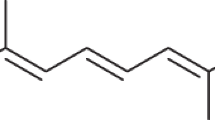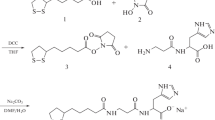Abstract
The cleavage products formed by autoxidation of lycopene were evaluated in order to elucidate possible oxidation products of lycopene in biological tissues. Lycopene solubilized at 50 μM in toluene, aqueous Tween 40, or liposomal suspension was oxidized by incubating at 37°C for 72 h. Among a number of oxidation products formed, eight products in the carbonyl compound fraction were identified as 3,7,11-trimethyl-2,4,6,10-dodecatetraen-1-al, 6,10,14-trimethyl-3,5,7,9,13-pentadecapentaen-2-one, acycloretinal, apo-14′-lycopenal, apo-12′-lycopenal, apo-10′-lycopenal, apo-8′-lycopenal, and apo-6′-lycopenal. These correspond to a series of products formed by cleavage in the respective 11 conjugated double bonds of lycopene. The maximal formation of acycloretinal was 135 nM in toluene, 49 nM in aqueous Tween 40, and 64 nM in liposomal suspension. Acycloretinoic acid was also formed by autoxidation of lycopene, although its formation was lower in the aqueous media than in toluene. The pig liver homogenate had the ability to convert acycloretinal to acycloretinoic acid, comparable to the conversion of all-trans-retinal to all-trans-retinoic acid. These results suggest that lycopene might be cleaved to a series of apolycopenals and short-chain carbonyl compounds under the oxidative conditions in biological tissues and that acycloretinal is further enzymatically converted to acycloretinoic acid.
Similar content being viewed by others
Abbreviations
- GC-MS:
-
gas chromatography-mass spectrometry
- HPLC:
-
high-performance liquid chromatography
- NMR:
-
nuclear magnetic resonance
- RAR:
-
retinoic acid receptor
- RXR:
-
retinoid X response
- UV-VIS:
-
ultraviolet-visible
References
Goodman, D.S., and Olson, J.A. (1969) The Conversion of All-trans-β-carotene into Retinal, Methods Enzymol. 15, 462–475.
Nagao, A., During, A., Hoshino, C., Terao, J., and Olson, J.A. (1996) Stoichiometric Conversion of All trans-β-Carotene to Retinal by Pig Intestinal Extract, Arch. Biochem. Biophys. 328, 57–63.
Wang, X.-D., Tang, G.-W., Fox, J.G., Krinsky, N.I., and Russell, R.M. (1991) Enzymatic Conversion of β-Carotene into β-Apo-carotenals and Retinoids by Human, Monkey, Ferret, and Rat Tissues, Arch. Biochem. Biophys. 285, 8–16.
Handelman, G.J., Van Kujik, F.J.G.M., Chatterjee, A., and Krinsky, N.I. (1991) Characterization of Products Formed During the Autoxidation of β-Carotene, Free Radical Biol. Med. 10, 427–437.
Mordi, R.C., Walton, J.C., Burton, G.W., Hughes, L., Ingold, K.U., Lindsay, D.A., and Moffatt, D.J. (1993) Oxidative Degradation of β-Carotene and β-Apo-8′-carotenal, Tetrahedron 49, 911–928.
McClure, T.D., and Liebler, D.C. (1995) A Rapid Method for Profiling the Products of Antioxidant Reactions by Negative Ion Chemical Ionization Mass Spectrometry, Chem. Res. Toxicol. 8, 128–135.
Stratton, S.P., Schaefer, W.H., and Liebler, D.C. (1993) Isolation and Identification of Singlet Oxygen Oxidation Products of β-Carotene, Chem. Res. Toxicol. 6, 542–547.
Baker, D.L., Krol, E.S., Jacobsen, N., and Liebler, D.C. (1999) Reactions of β-Carotene with Cigarette Smoke Oxidants. Identification of Carotenoid Oxidation Products and Evaluation of the Prooxidant/Antioxidant Effect, Chem. Res. Toxicol. 12, 535–543.
Yeum, K.J., Lee-Kim, Y.C., Yoon, S., Lee, K.Y., Park, I.S., Lee, K.S., Kim, B.S., Tang, G., Russell, R.M., and Krinsky, N.I. (1995) Similar Metabolites Formed from β-Carotene by Human Gastric Mucosal Homogenates, Lipoxygenase, or Linoleic Acid Hydroperoxide, Arch. Biochem. Biophys. 321, 167–174.
Wu, Z., Robinson, D.S., Hughes, R.K., Casey, R., Hardy, D., and West, S.I. (1999) Co-oxidation of β-Carotene Catalyzed by Soybean and Recombinant Pea Lipoxygenases, J. Agric. Food Chem. 47, 4899–4906.
Lutz-Roder, A., Jezussek, M., and Winterhalter, P. (1999) Nickel Peroxide-Induced Oxidation of Canthaxanthin, J. Agric. Food Chem. 47, 1887–1891.
Nikawa, T., Schulz, W.A., van den Brink, C.E., Hanusch, M., van der Saag, P., Stahl, W., and Sies, H. (1995) Efficacy of All-trans-β-carotene, Canthaxanthin, and All-trans-, 9-cis, and 4-Oxoretinoic Acids in Including Differentiation of an F9 Embryonal Carcinoma RARβ-lacZ Receptor Cell Line, Arch. Biochem. Biophys. 316, 665–672.
Hanusch, M., Stahl, W., Schulz, W.A., and Sies, H. (1995) Induction of Gap Junctional Communication by 4-Oxoretinoic Acid Generated from Its Precursor Canthaxanthin, Arch. Biochem. Biophys. 317, 423–428.
Hu, X., White, K.M., Jacobsen, N.E., Mangelsdorf, D.J., and Canfield, L.M. (1998) Inhibition of Growth and Cholesterol Synthesis in Breast Cancer Cells by Oxidation Products of β-Carotene, J. Nutr. Biochem. 9, 567–574.
Bausch, J., Liechti, H., Oesterhelt, G., and Kistler, A. (1999) Isolation and Identification of a Major Urinary Canthaxanthin Metabolite in Rats, Int. Vitam. Nutr. Res. 69, 268–272.
Wolz, E., Liechti, H., Notter, B., Oesterhelt, G., and Kistler, A. (1999) Characterization of Metabolites of Astaxanthin in Primary Cultures of Rat Hepatocytes, Drug Metab. Dispos. 27, 456–462.
Giovannucci, E., Ascherio, A., Rimn, E.B., Stampfer, M.J., Colditz, G.A., and Willett, W.C. (1995) Intake of Carotenoids and Retinol in Relation to Risk of Prostate Cancer, J. Natl. Cancer Inst. 87, 1767–1776.
Gann, P.H., Ma, J., Giovannucci, E., Willett, W., Sacks, F.M., Hennekens, C.H., and Stampfer, M.J. (1999) Lower Prostate Cancer Risk in Men with Elevated Plasma Lycopene Levels: Results of a Prospective Analysis, Cancer Res. 59, 1225–1230.
Klipstein-Grobusch, K., Launer, L.J., Geleijnse, J.M., Boeing, H., Hofman, A., and Witteman, C.M. (2000) Serum Carotenoids and Atherosclerosis—The Rotterdam Study, Arteriosclerosis 148, 49–56.
Suganuma, H., and Inakuma, T. (1999) Protective Effect of Dietary Tomato Against Endothelial Dysfunction in Hypercholesterolemic Mice, Biosci. Biotech. Biochem. 63, 78–82.
Jain, C.K., Agarwal, S., and Rao, A.V. (1999) The Effect of Dietary Lycopene on Bioavailability, Tissue Distribution, in vivo Antioxidant Properties and Colonic Preneoplasia in Rats, Nutr. Res. 19, 1383–1391.
Arimochi, H., Kataoka, K., Kuwahara, T., Nakayama, H., Misawa, N., and Ohnishi, Y. (1999) Effects of Beta-glucuronidase-Deficient and Lycopene-Producing Escherichia coli Strains on Formation of Azoxymethane-Induced Aberrant Crypt Foci in the Rat Colon, Biochem. Biophys. Res. Commun. 262, 322–327.
Narisawa, T., Fukaura, Y., Hasebe, M., Ito, M., Aizawa, R., Murakoshi, M., Uemura, S., Khachik, F., and Nishino, H. (1996) Inhibitory Effects of Natural Carotenoids, α-Carotene, β-Carotene, Lycopene and Lutein, on Colonic Aberrant Crypt Foci Formation in Rats, Cancer Lett. 107, 137–142.
Stahl, W., von Laar, J., Martin, H.D., Emmerich, T., and Sies, H. (2000) Stimulation of Gap Junctional Communication: Comparison of Acyclo-Retinoic Acid and Lycopene, Arch. Biochem. Biophys. 373, 271–274.
Amir, H., Karas, M., Giat, J., Danilenko, M., Levy, R., Yermiahu, T., Levy, J., and Sharoni, Y. (1999) Lycopene and 1,25-Dihydroxyvitamin D−3 Cooperate in the Inhibition of Cell Cycle Progression and Induction of Differentiation in HL-60 Leukemic Cells, Nutr. Cancer Internat. J. 33, 105–112.
Pastori, M., Pfander, H., Boscoboinik, D., and Azzi, A. (1998) Lycopene in Association with Alpha-Tocopherol Inhibits Physiological Concentrations Proliferation of Prostate Carcinoma Cells, Biochem. Biophys. Res. Commun. 250, 582–585.
Levy, J., Bosin, E., Feldman, B., Giat, Y., Miinster, A., Danilenko, M., and Sharoni, Y. (1995) Lycopene Is a More Potent Inhibitor of Human Cancer Cell Proliferation Than Either Alpha-Carotene or Beta-Carotene, Nutr. Cancer 24, 257–266.
Zhang, L.X., Cooney, R.V., and Bertram, J.S. (1991) Carotenoids Enhance Gap Junctional Communication and Inhibit Lipid Peroxidation in C3H/10T1/2 Cells: Relationship to Their Cancer Chemopreventive Action, Carcinogenesis 12, 2109–2114.
Rao, A.V., and Agarwal, S. (1999) Role of Lycopene as Antioxidant Carotenoid in the Prevention of Chronic Disease: A Review, Nutr. Res. 19, 305–323.
Mascio, P.D., Kaiser, S., and Sies, H. (1989) Lycopene as the Most Efficient Biological Carotenoid Singlet Oxygen Quencher, Arch. Biochem. Biophys. 274, 532–538.
Ojima, F., Sakamoto, H., Ishiguro, Y., and Terao, J. (1993) Consumption of Carotenoids in Photosensitized Oxidation of Human Plasma and Plasma Low-Density Lipoprotein, Free Radical Biol. Med. 15, 377–384.
Ukai, N., Lu, Y., Etoh, H., Tagi, A., Ina, K., Oshima, S., Ojima, F., Sakamoto, H., and Ishiguro, Y. (1994) Photosensitized Oxygenation of Lycopene, Biosci. Biotech. Biochem. 58, 1718–1719.
Lu, Y., Etoh, H., Watanabe, N., Ina, K., Ukai, N., Oshima, S., Ojima, F., Sakamoto, H., and Ishiguro, Y. (1995) New Carotenoid, Hydrogen Peroxide Oxidation Products from Lycopene, Biosci. Biotech. Biochem. 59, 2153–2155.
Ben-Aziz, A., Britton, G., and Goodwin, T.W. (1973) Carotene Epoxides of Lycopersicon escculentum, Phytochemistry 12, 2759–2764.
Khachik, F., Beecher, G.R., and Smith, J.C., Jr. (1995) Lutein, Lycopene, and Their Oxidative Metabolites in Chemoprevention of Cancer, J. Cell. Biochem. 22, 236–246.
Zumbrunn, A., Uebelhart, P., and Eugster, C.H. (1985) Synthesis of Carotenes with ψ-End Groups and (Z)-Configuration at Terminal Conjugated Double Bonds, Helv. Chim. Acta 68, 1519–1539.
Tsujimoto, K., Aoki, M., and Ohashi, M. (1992) Stereoselective Photoisomerization of φ-Retinal, J. Photochem. Photobiol. A: Chem. 65, 73–78.
Barua, R.K., and Barua, A.B. (1964) Vitamin A Acid from Retinene, Biochem. J. 92, 21c-22c.
Davis, J.B., Jackman, L.M., Siddons, P.T., and Weedon, B.C.L. (1966) Carotenoids and Related Compounds. Part XV. The Structure and Synthesis of Phytoene, Phytofluene, ξ-Carotene, and Neurosporene, J. Chem. Soc. C, 23, 2154–2165.
Märki-Fischer, E., Uebelhart, P., and Eugster, C.H. (1987) 10′-Apolycopen-10′-ol and 10−Apolycopene-10′-oic acid from the Petals of the Rose Hybrid ‘Maréchal niel’, Helv. Chim. Acta 70, 1994–2002.
Barua, A.B., and Goswami, B.C. (1979) Carotenoids of Cephalandra indica (Coccinia indica), Current Sci., 48, 630–632.
Napoli, J.L., and Race, K.R. (1987) The Biosynthesis of Retinoic Acid from Retinol by Rat Tissues in vitro, Arch. Biochem. Biophys. 255, 95–101.
Bradford, M.M. (1976) A Rapid and Sensitive Method for the Quantitation of Microgram Quantities of Protein Utilizing the Principle of Protein-Dye Binding, Anal. Biochem. 72, 248–254.
Napoli, J.N. (1993) Biosynthesis and Metabolism of Retinoic Acid: Roles of CRBP and CRABP in Retinoic Acid: Roles of CRBP and CRABP in Retinoic Acid Homeostasis, J. Nutr. 123, 362–366.
Araki, H., Shidoji, Y., Yamada, Y., Moriwaki, H., and Muto, Y. (1995) Retinoid Agonist Activities of Synthetic Geranyl Geranoic Acid Derivatives, Biochem. Biophys. Res. Commun. 209, 66–72.
Duitsman, P.K., Barua, A.B., Becker, B., and Olson, J.A. (1999) Effects of Epoxycarotenoids, β-Carotene, and Retinoic Acid on the Differentiation and Viability of the Leukemia Cell Line NB4 in vitro, Int. J. Vitam. Nutr. Res. 69, 303–308.
Author information
Authors and Affiliations
Corresponding author
About this article
Cite this article
Kim, SJ., Nara, E., Kobayashi, H. et al. Formation of cleavage products by autoxidation of lycopene. Lipids 36, 191–200 (2001). https://doi.org/10.1007/s11745-001-0706-8
Received:
Revised:
Accepted:
Issue Date:
DOI: https://doi.org/10.1007/s11745-001-0706-8




